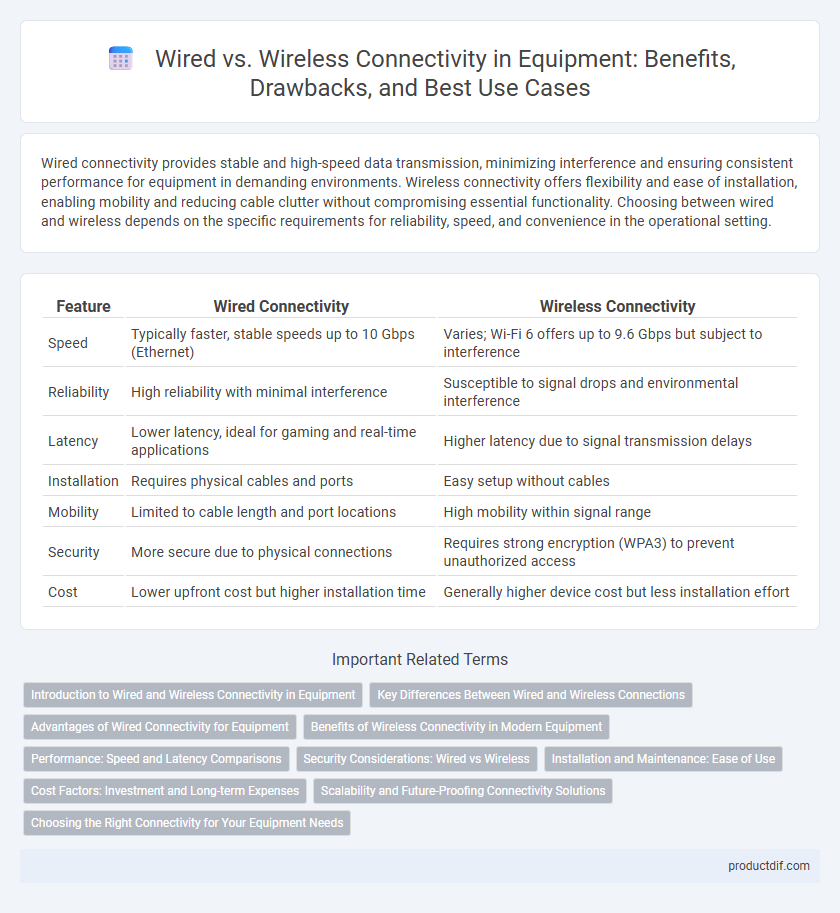Wired connectivity provides stable and high-speed data transmission, minimizing interference and ensuring consistent performance for equipment in demanding environments. Wireless connectivity offers flexibility and ease of installation, enabling mobility and reducing cable clutter without compromising essential functionality. Choosing between wired and wireless depends on the specific requirements for reliability, speed, and convenience in the operational setting.
Table of Comparison
| Feature | Wired Connectivity | Wireless Connectivity |
|---|---|---|
| Speed | Typically faster, stable speeds up to 10 Gbps (Ethernet) | Varies; Wi-Fi 6 offers up to 9.6 Gbps but subject to interference |
| Reliability | High reliability with minimal interference | Susceptible to signal drops and environmental interference |
| Latency | Lower latency, ideal for gaming and real-time applications | Higher latency due to signal transmission delays |
| Installation | Requires physical cables and ports | Easy setup without cables |
| Mobility | Limited to cable length and port locations | High mobility within signal range |
| Security | More secure due to physical connections | Requires strong encryption (WPA3) to prevent unauthorized access |
| Cost | Lower upfront cost but higher installation time | Generally higher device cost but less installation effort |
Introduction to Wired and Wireless Connectivity in Equipment
Wired connectivity in equipment relies on physical cables such as Ethernet or USB to establish stable and fast data transfer with minimal interference. Wireless connectivity uses radio signals like Wi-Fi or Bluetooth, enabling flexible and convenient device communication without physical constraints. Choosing between wired and wireless connectivity depends on factors like speed requirements, environmental conditions, and mobility needs in various industrial or consumer applications.
Key Differences Between Wired and Wireless Connections
Wired connectivity offers stable, high-speed data transmission with minimal latency, making it ideal for environments requiring consistent performance and security. Wireless connectivity provides flexibility and mobility, enabling devices to connect without physical cables, though it may experience interference and variable speeds. Key differences include wiring requirements, signal stability, data transfer rates, and susceptibility to security risks.
Advantages of Wired Connectivity for Equipment
Wired connectivity for equipment provides reliable and stable data transmission, minimizing latency and interference common in wireless connections. It ensures consistent power supply and enhanced security, reducing the risks of unauthorized access or signal disruptions. High-speed Ethernet cables support heavy data loads, making wired connections ideal for critical operations and large-scale industrial equipment.
Benefits of Wireless Connectivity in Modern Equipment
Wireless connectivity in modern equipment offers superior flexibility, enabling seamless device mobility without physical cable constraints, which enhances user experience and productivity. It supports rapid deployment and scalability in complex environments by eliminating wiring infrastructure, reducing installation and maintenance costs. Advanced wireless technologies, such as Wi-Fi 6 and Bluetooth 5.2, provide high-speed data transfer, low latency, and robust security, making wireless solutions ideal for dynamic and interconnected ecosystems.
Performance: Speed and Latency Comparisons
Wired connectivity consistently delivers higher speeds and lower latency than wireless connections, making it ideal for performance-critical applications such as gaming and video editing. Ethernet cables can support speeds up to 10 Gbps with minimal interference, while Wi-Fi speeds vary based on signal strength and network congestion, often resulting in higher latency. Low latency in wired setups ensures real-time data transmission, crucial for tasks requiring instantaneous response times.
Security Considerations: Wired vs Wireless
Wired connectivity offers enhanced security through physical connections that reduce the risk of unauthorized access and cyberattacks compared to wireless networks. Wireless connectivity exposes data to potential interception and requires robust encryption protocols like WPA3 and regular security updates to mitigate vulnerabilities. Proper network segmentation and monitoring are crucial for both wired and wireless systems to protect sensitive equipment and data.
Installation and Maintenance: Ease of Use
Wired connectivity requires physical cables and connectors, leading to longer installation times and limited flexibility, while offering stable and consistent signal transmission. Wireless connectivity enables quicker and more flexible installation since it eliminates the need for physical wiring, but it may demand regular maintenance to address interference and signal drops. The ease of use in maintenance favors wired systems for their reliability, whereas wireless setups benefit from accessibility and simpler reconfiguration.
Cost Factors: Investment and Long-term Expenses
Wired connectivity generally requires higher initial investment due to the costs of cables, installation, and infrastructure setup, but it tends to have lower long-term expenses because of stable performance and minimal maintenance. Wireless connectivity often has lower upfront costs as it eliminates extensive cabling needs, yet ongoing expenses can increase due to frequent upgrades, security maintenance, and potential signal interference remedies. Evaluating total cost of ownership requires considering equipment lifespan, scalability demands, and environment-specific factors impacting both wired and wireless solutions.
Scalability and Future-Proofing Connectivity Solutions
Wired connectivity offers stable and secure data transmission, making it ideal for environments requiring high bandwidth and low latency, but it limits scalability due to physical constraints and installation costs. Wireless connectivity provides greater scalability with easier deployment and flexibility, supporting rapid expansion and integration of new devices without extensive infrastructure changes. Future-proofing connectivity solutions increasingly favors wireless technologies as they adapt to evolving standards like Wi-Fi 6E and 5G, enabling seamless upgrades and enhanced network capacity.
Choosing the Right Connectivity for Your Equipment Needs
Wired connectivity offers faster data transfer speeds and more reliable connections, making it ideal for high-performance equipment like gaming consoles and desktop computers. Wireless connectivity provides flexibility and ease of installation, perfect for devices requiring mobility such as laptops, smartphones, and IoT sensors. Assess equipment usage, required bandwidth, and environmental factors to determine the optimal connectivity solution for your specific needs.
Wired connectivity vs wireless connectivity Infographic

 productdif.com
productdif.com